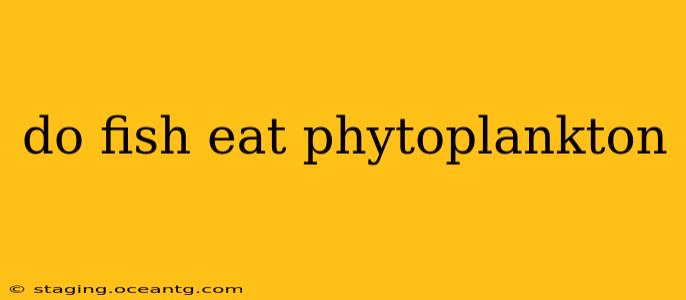Many fish species, particularly smaller ones and those in their larval stages, rely on phytoplankton as a crucial part of their diet. While not all fish consume phytoplankton directly, it forms the base of the aquatic food web, indirectly supporting a vast majority of fish populations. Let's explore this fascinating relationship in more detail.
What are Phytoplankton?
Before we delve into fish consumption, it's important to understand what phytoplankton actually are. Phytoplankton are microscopic, plant-like organisms that drift in the water column. They are photosynthetic, meaning they produce their own food using sunlight, just like plants on land. They are incredibly diverse, encompassing a wide range of species including diatoms, dinoflagellates, and coccolithophores. These tiny organisms are the foundation of most aquatic ecosystems, forming the base of the food chain.
Which Fish Eat Phytoplankton?
Not all fish are herbivores, but many smaller species, especially those in their juvenile stages, directly consume phytoplankton. Examples include:
- Many larval fish: Newly hatched fish often lack the jaw structure and hunting skills to capture larger prey. Phytoplankton provides the essential nutrients for their initial growth and development.
- Silverside: This small, schooling fish is a known phytoplankton consumer.
- Certain carp species: Some carp species are known to filter feed on phytoplankton and other microscopic organisms.
- Gizzard shad: This fish is an excellent example of a filter feeder that plays a crucial role in consuming phytoplankton and regulating algal blooms.
How Do Fish Consume Phytoplankton?
Fish consume phytoplankton through different feeding mechanisms:
- Filter feeding: Many fish have specialized structures like gill rakers that strain the water, filtering out phytoplankton and other small organisms.
- Direct grazing: Some fish directly graze on phytoplankton patches.
What Role Do Phytoplankton Play in the Aquatic Food Web?
Phytoplankton are primary producers, meaning they convert sunlight into energy through photosynthesis. This energy is then transferred to higher trophic levels. Even fish that don't directly consume phytoplankton benefit indirectly. Small crustaceans, zooplankton, feed on phytoplankton, and these zooplankton are then consumed by larger fish. This intricate web illustrates the critical role phytoplankton plays in maintaining the health and balance of aquatic ecosystems.
Are There Any Negative Impacts of Phytoplankton Consumption?
While phytoplankton are generally beneficial, excessive blooms (harmful algal blooms or HABs) can produce toxins that can affect fish and other aquatic life. These toxins can accumulate in the tissues of fish, posing a potential risk to consumers further up the food chain, including humans.
What Happens When Phytoplankton Levels Are Low?
Low phytoplankton levels can trigger a cascade effect throughout the aquatic food web. This can lead to reduced food availability for zooplankton, which in turn affects fish populations that rely on zooplankton as a food source. This highlights the crucial role of phytoplankton in maintaining a healthy and balanced aquatic ecosystem.
Do all fish eat phytoplankton at some point in their lives?
No, not all fish consume phytoplankton at any point in their life cycle. Many fish species are carnivores or omnivores, relying on other animals or plants (other than phytoplankton) for sustenance. However, the importance of phytoplankton as the base of the food web cannot be overstated, as it indirectly supports the vast majority of fish populations.
This detailed explanation addresses the main question and provides additional information to offer a comprehensive understanding of the topic. The inclusion of examples and clarification of different feeding mechanisms significantly enhances the article's value and depth. Remember, understanding the complexities of the aquatic food web is critical for effective conservation and management of our aquatic resources.
